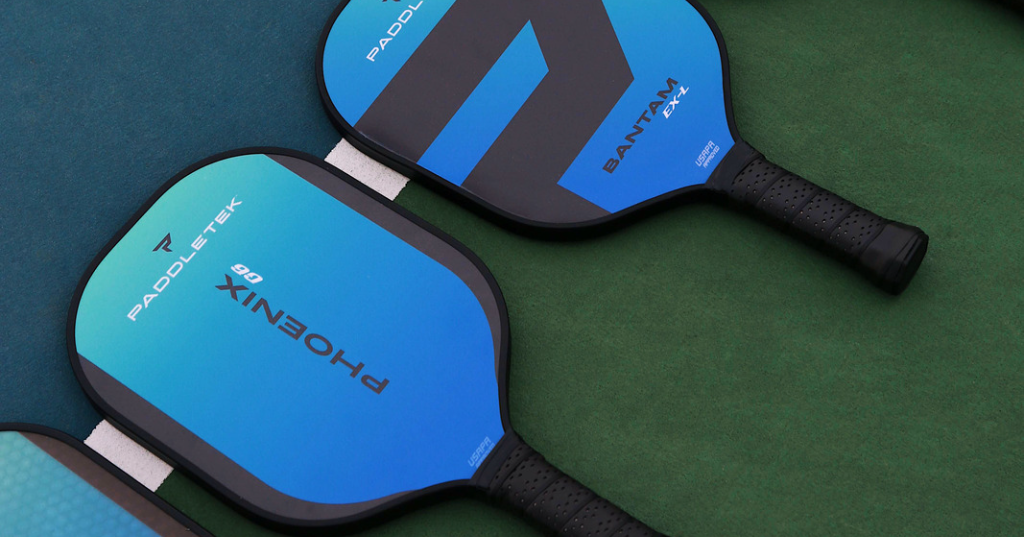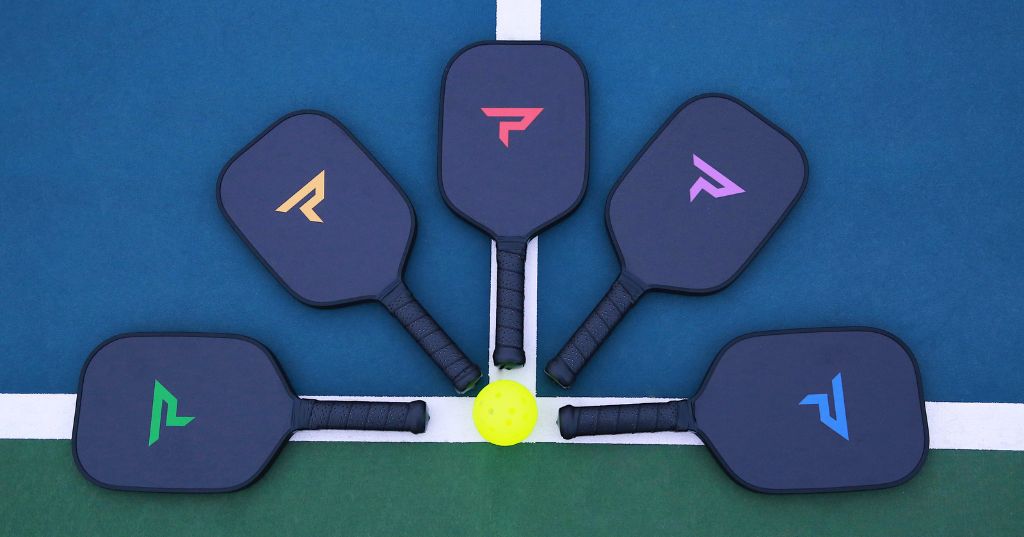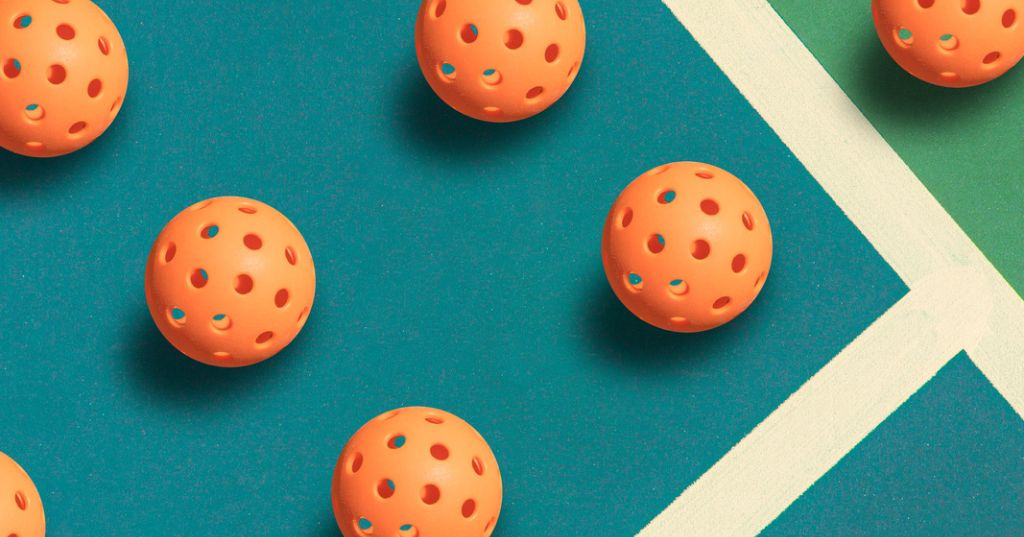Whether you’re an experienced veteran with multiple paddles or a beginner looking for your first, odds are you found this guide because you’re doing some online shopping for a new pickleball paddle. Some of the terminology out there can be inflated and confusing, especially as new manufacturers pop up and try to differentiate their paddles from the rest of the market. This guide will help you cut through the noise and pick the paddle that’s right for you.
The fact is, there are multiple layers to pickleball paddle shopping. Imagine two umbrellas: one labeled “power” and the other labeled “control.” Beneath these umbrellas, there are categories like “surface material” and “core material.” Each pickleball paddle is made from a unique combination of these elements.
In this article, we will lay out clearly what is meant by power and control. This will allow you to determine your playstyle and help you make a decision. This article will also serve as a wayfinding tool to our other pickleball paddle buying guides where you can get all the details you want for each component and combination to make the perfect paddle.
Breaking Down the Basics: Power vs Control
Power and control are the most common terms you’re going to see when browsing the internet for a new pickleball paddle.
They refer to their respective playstyles: a “power” player values hard hits and powerful play, while a “control” player cares more about making those precision shots and controlling exactly where the ball will land - they embrace finesse.
To determine your playstyle, think about how you act in games. Are you driving the ball every chance you get, hitting shots so fast and strong that your opponent couldn’t dream of returning them? Has anyone ever called you a banger, or are you a little bit different from that, referred to as an aggressive player - choosing when to go hard or light on a shot?
Or are you more careful and play those precise shots, looking for your opportunity to place a shot so perfectly that even a contortionist couldn’t hit it?
What Elements Determine Your Power/Control Factor?
Pickleball paddles are comprised of so many elements that choosing just one to decide from is a bit of a dangerous game. We've covered 11 all-encompassing factors, but if you're looking for something a bit shorter to take into account, consider this your precursor to that.
The five components below account for far broader components, and are not exhaustive but get these factors right, and you'll be able to balance your paddle to your power and control requirements. Here are the five factors to get power and control just where you like it in your paddle:
- Paddle Weight: Arguably the most important element of a paddle - the weight of your paddle affects how easily and quickly you can swing it and how hard it hits.
- Paddle Core: The core of a paddle can be made of different materials, each affecting the density and overall thickness of your paddle. In turn, this changes the size and effectiveness of the sweet spot.
- Paddle Face: The face can be made of different materials that change how much grit a paddle has, as well as how much energy is absorbed and returned when hitting the ball. This changes how hard you need to swing and how long the ball will remain on the surface of your paddle as it is being returned.
- Paddle Shape: All pickleball paddles are sized within national regulations, meaning that the length + width of the paddle may not exceed 24.0 inches. The shape of the paddle alters many things, including the size of the sweet spot.
- Paddle Handle: Finally, the handle of your pickleball paddle is incredibly important to your gameplay. How long your handle is affected by how far away from your body the sweet spot of your paddle is, which has a huge effect on your power/control. A longer handle is also more comfortable if you use two-handed backhands.
If those 5 summaries are the super-abridged version of our buyer's guide, consider the following simply the abridged buyer's guide to paddle shopping.
5 Important Elements Impacting Paddle Power and Control
So, we have five pieces of the puzzle. But how do they fit together to make that perfect paddle for your play style? To know this, we need to look closer at these elements and how exactly they change a paddle’s performance. Learning about these elements will help you when choosing your own paddle’s characteristics!
Piece #1: Paddle Weight
As stated previously, the weight of your paddle is arguably the most important puzzle piece, that's why we've created an entire guide on choosing the right pickleball paddle weight.
The weight of your paddle affects everything from how fast you can swing it to how tired your arm is going to get after playing multiple games. Pickleball paddles can weigh less than 7.3 ounces to more than 8.3 ounces. This might not sound like a huge range, but it makes a big difference - the kind you can feel.
Lightweight Paddles - Control
Paddles that weigh less than 7.3 ounces are considered “lightweight.” These lighter paddles are better for paddle speed, as they are faster and easier to maneuver when you get into intense hand battles with your opponents. This makes them great for being around the kitchen - quick reaction time and improved agility to meet the ball.
As a word of caution, the lighter weight of these paddles means they absorb less energy when the ball hits them, so you'll feel that in your arms.
Heavy Paddles - Power
Paddles that are above 8.3 ounces are considered “heavy.” As you likely guessed, these paddles are slower to maneuver, but they pack a heavy punch. These heavier paddles will help add some gusto to each shot. You can drive the ball with ease but be prepared for earlier fatigue compared to lighter alternatives.
Midweight Paddles - Balance of Power and Control
Anything in the range of 7.3 and 8.3 oz is a midweight paddle. These weights offer a healthy mix of both worlds, perfect for blended play styles and beginners looking to experiment.
It’s very important to try different paddles and find the paddle weight that works best for you. A paddle that is too heavy can cause arm strain and lead to injury. One that is too light requires you to have to swing harder to get power behind your shots and can also lead to injury by overextending.
You can always add weight with some lead tape as well, so if you have a paddle you think is too light and you're on the market for a heavier one, this could be a good way to get a feel of it. Just know that where you tape will impact the balance of weight, an often undiscussed but wildly important subcategory of paddle weight (question number 6 on this questionnaire will walk you through the importance of swingweight.)
Piece #2: Paddle Core
It’s what’s on the inside that counts! For pickleball paddles, this is especially true. The core of a paddle can have a drastic effect on its performance and the way you will want to play the game.
This is another category that can be as simple or complicated as you'd like.
Since this guide is the 50,000-foot view, if you want the full details on it, be sure to check out Paddletek's proper paddle buying guide - the first two sections exclusively discuss core materials and thickness - plus you get to see what the core actually looks like from one of our paddles.
Pickleball paddle cores have two main elements we'll touch on here, thickness and material:
Core Thickness
Paddle cores come in a range of thicknesses typically between 11mm and 16mm, however, it's important to note that there are no official rules regulating paddle thickness.
Thin Cores: Power
Cores that are between 10 and 13 mm thick are on the thinner side. These paddles with thinner cores have less energy absorption and therefore will reflect more energy to the ball as it strikes your paddle. This excellent energy reflection allows for more powerful shots with less effort, great for power players.
Thick Cores: Control
Cores that are 16mm or thicker are considered thick and the ideal paddle for players who want more control. These thicker cores absorb more energy from the ball as it strikes the paddle, allowing players to fine-tune their responses. Thicker paddles are also more stable. This stability is important when the ball strikes near the edges of your paddle, helping to reduce dead shots and increase accuracy.
Beginners excel with thicker cores and some of the top players in the world prefer them as well!
Core Material
There are several core materials available on the market, but polymer materials are the gold standard at this point - you may see it as polypropylene, polycore, or just plain poly.
The core is shaped like a honeycomb, a shape that maximizes sturdiness while minimizing the necessary material which saves weight. The density of a core is determined by the size of the honeycombs, with smaller honeycombs being packed more tightly into the core, making it denser.
The density of the core affects the hardness of the paddle. Denser cores give a paddle a harder surface, while more open and airy cores make for a softer paddle. This also impacts the weight of the paddle.
The hardness of the polymer also affects its performance. The harder polymer absorbs less energy and reflects more energy to the ball, allowing for more powerful shots with less backswing. Softer polymer cores absorb more energy, enhancing your control of the ball.
Polymer cores can vary wildly in quality. A low-quality core may be cheaper but will break down and hit inconsistently much more quickly than an expensive paddle with a high-quality core. But you also have high-end polymers on the market like Paddletek's Tempest Wave, which uses an advanced high-grade carbon fiber polymer.

Piece #3: Paddle Face
The material of the face on your paddle is also an important factor in determining your power and control levels with it - so important, we've also created literature that walks you through three of the most common options. The face material impacts how much energy your paddle does or does not absorb. This changes how much effort is needed to strike the ball and how long the ball remains on the face of the paddle when returning a shot.
Before jumping into the face materials, we should mention grit. Grit is the roughness on a paddle face that enhances your ability to add or change spin, as it allows the paddle to grip the ball when hitting. There is a limit to the amount of grit a paddle can have and different paddle face materials offer different amounts of grit.
With that out of the way, here are the three main materials that most manufacturers use to craft the faces of their paddles:
Fiberglass - Power
Once upon a time, fiberglass was the most popular face material, until carbon fiber came along. It's still everywhere, but losing its grip on the market as the go-to option. But it still has a great role to play for some players.
Fiberglass is a dynamic material, absorbing the minimum amount of energy from the ball as it collides with the face. This makes for a fast-playing paddle that’s capable of hitting balls back with almost as much power as they came over with.
One drawback of fiberglass is that it does reduce the size of the sweet spot because it is softer and more flexible than carbon fiber or graphite.
Carbon Fiber - Refined Power and Touch
Carbon fiber is a widely sought-after surface material today. This material is harder and less flexible than fiberglass, absorbing more energy on your strike and providing more control. This also enlarges the sweet spot of the paddle, while taking away very little of your power in the process. Carbon fiber is also very durable.
Graphite - Control
Graphite acts similarly to carbon fiber - it's a hard material that absorbs more energy, providing players with more control over the ball.

Piece #4: Paddle Shape
All pickleball paddle manufacturers follow the guidelines listed in the USA Pickleball Equipment Standards Manual. There are two main rules to follow: pickleball paddles cannot be longer than 17 inches, and the combined length and width total cannot exceed 24 inches. Other than that, just about anything goes in terms of shape.
The shape of a paddle mainly affects the location of the sweet spot, but the reach of the paddle does impact power exertion. A longer paddle generally means that the sweet spot will be higher up on the face, and therefore farther away from your hand.
Elongated paddles give players more leverage, allowing for stronger shots at the cost of a smaller sweet spot due to the paddle’s comparative dimensions. These lengthy paddles also have the added benefit of an extended reach and are popular with tennis players converting to pickleball.
A shorter, fatter paddle on the other hand will have a larger sweet spot that is closer to your hand, giving you much more precision and control over your shots. Shorter paddles sacrifice their reach for that large sweet spot that leaves a lot of forgiveness for mistakes.
A notable drawback is that shorter paddles make for less power in your shots. Players with ping pong backgrounds will appreciate the familiar shape of these shorter paddles.

Piece #5: Handle Length
The final piece of this paddle puzzle is choosing a proper handle length - not to be confused with grip size, which is more about the circumference of the handle. That is certainly an incredibly important factor, but that is such a customized component relative to power and control, that it's difficult to advise one over the other since the measurement is too personalized.
One of the main variables when changing the handle length of your paddle is adjusting how far away the sweet spot is from your hand, and therefore how much leverage and control you have. A long handle will pull the sweet spot away from your body, which as we mentioned before gives you more leverage and therefore more power behind your swing. A shorter handle does the opposite, giving you more precise control over your shots at the cost of power.
New players often start with shorter handles, as they are not as experienced in the game and are therefore not as consistent at hitting the sweet spot every time. A longer handle might mean a harder time hitting the sweet spot, but it might also improve your reach. Longer handles also allow for adding a 2nd hand to your grip for a two-handed backhand - although not a common grip, there are a handful of pros that use a two-handed backhand.
Choosing a handle really comes down to feeling. Try playing with different handle lengths to determine what best fits your hand and what compliments your performance most.

Still Having Trouble Choosing?
This is a lot of information and it can absolutely feel overwhelming. For new players especially, remember that going with paddles that don’t lead too hard into power or control is your best bet. This will help you understand your playing style and whether you tend to play more power or control. Then, once you have fine-tuned your game, you will know exactly what you want out of your next paddle!
If you’re looking for a good place to start, we at Paddletek have three paddle lines that can get you on the right track in your search:
Our Bantam-Series paddles are made for power plays. Drive the ball across the court with paddles designed for maximum pop and a dynamic sweet spot. Our legendary Bantam series delivers unbeatable power without sacrificing control.
If you’re more into a control game, look no further than our Tempest-Series. Place the ball exactly where you want it with unmatched control and accuracy. The Tempest series prioritizes precision and speed—making these paddles an ideal choice for strategic players.
Finally, if you’re looking for a hybrid paddle or you’re new to this amazing game, I highly recommend our Phoenix-Series. Strike a balance between power and control with paddles designed to give you a competitive edge. The Phoenix series delivers forgiveness and playability to improve your performance game after game.



Leave a comment
This site is protected by hCaptcha and the hCaptcha Privacy Policy and Terms of Service apply.